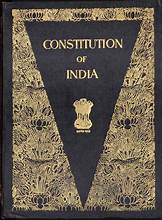Neha Jain, a – 2nd Year student of Lala Lajpatrai College of Law, Mumbai University has written this article “PREAMBLE OF THE CONSTITUTION OF INDIA: A CRITICAL ANALYSIS”
INTRODUCTION
The Preamble of the Constitution of India stands as a solemn and profound declaration of the aspirations, values, and objectives that guide the nation. It is the preamble that sets the tone for the entire Constitution, outlining the fundamental principles upon which the Indian Republic is built. In this critical analysis, we will delve into the Preamble of the Constitution of India, dissecting its significance, historical context, and the principles it encapsulates, as well as its role in the Indian legal framework.
THE HISTORICAL CONTEXT: PREAMBLE OF THE CONSTITUTION OF INDIA: A CRITICAL ANALYSIS
To understand the Preamble’s significance, it is crucial to delve into the historical context in which it was conceived. India was under British colonial rule for nearly two centuries, and its struggle for independence was marked by a diverse array of ideologies and movements. The drafting of the Indian Constitution began in 1947, following India’s independence from British rule, and concluded in 1950 when the Constitution came into effect.
The framers of the Constitution, led by Dr. B.R. Ambedkar, faced the daunting task of building a united and inclusive nation from a deeply diverse and divided society. India was home to people of various religions, languages, castes, and cultures, and it was essential to ensure that the Constitution could accommodate this diversity while providing a common framework for governance.
The Preamble emerged as a result of extensive debates and discussions among the Constituent Assembly members. It reflects the shared vision of a new India, one that was democratic, secular, and committed to social justice. The Preamble serves as a compass, guiding the nation towards these objectives.
Objective Resolution:
The first significant step towards the Preamble came with Jawaharlal Nehru’s presentation of the “Objective Resolution” on December 13, 1946. This resolution laid the foundation for the Preamble, emphasizing the principles of liberty, equality, and fraternity. It was eventually adopted on January 22, 1947.
Pandit Thakur Das Bhargava Case (1949)[1]:
In this early case, the Allahabad High Court held that the Preamble could not be used as a source of legislative power. It was a crucial decision that underlined the symbolic nature of the Preamble, emphasizing that it does not confer any substantive power.
Berubari Case (1960)[2]:
The Berubari case tested the Preamble’s significance in territorial disputes. The Supreme Court held that the Preamble could not alter the boundaries of India. It reiterated the Preamble’s symbolic importance and its inability to override specific provisions of the Constitution.
THE TEXT OF THE PREAMBLE
The Preamble of the Indian Constitution reads as follows:
“We, the people of India, having solemnly resolved to constitute India into a Sovereign Socialist Secular Democratic Republic and to secure to all its citizens:
- Justice, social, economic, and political;
- Liberty of thought, expression, belief, faith, and worship;
- Equality of status and of opportunity;
- And to promote among them all
- Fraternity assuring the dignity of the individual and the unity and integrity of the Nation;
In our constituent assembly this twenty-sixth day of November 1949, do hereby adopt, enact, and give to ourselves this Constitution.”
KEY ELEMENTS OF THE PREAMBLE
“We, the people of India”:
The Preamble begins with a clear assertion that the Constitution is being made by the people of India. This phrase underscores the democratic foundation of the Indian Republic, emphasizing that ultimate power resides with the citizens.
In the landmark case of Kesavananda Bharati v. State of Kerala (1973)[3], the Supreme Court held that the Preamble could be amended as long as the basic structure of the Constitution remains intact, further affirming the sovereignty of the people.
“Sovereign Socialist Secular Democratic Republic”:
These four adjectives hold profound significance:
- Democratic: The people of India have the right to elect their representatives and participate in governance.
- “Justice, social, economic, and political”: The Preamble pledges to secure justice in various dimensions. Social justice entails addressing historical inequalities, economic justice aims to reduce economic disparities, and political justice guarantees political equality and representation. The Supreme Court, in numerous cases, has invoked these principles to protect individual rights and uphold the rule of law.
- “Liberty of thought, expression, belief, faith, and worship”: This clause guarantees individual freedoms, including freedom of speech, expression, and religion. It underscores the importance of preserving personal liberties.
- “Equality of status and of opportunity”: This commitment is fundamental to ensuring that all citizens, regardless of their background, have equal rights and opportunities.
- “Fraternity assuring the dignity of the individual and the unity and integrity of the Nation”: Fraternity emphasizes the importance of a sense of brotherhood and solidarity among citizens. It aims to create a harmonious society that respects individual dignity and preserves the unity and integrity of the nation. In Indira Nehru Gandhi v. Raj Narain (1975)[4], the Supreme Court highlighted the importance of fraternity in maintaining the democratic fabric of the country. It stressed that citizens must work together for the common good, transcending narrow interests.
SECULARISM AND SOCIALISM
The Preamble was amended in 1976 to include the terms “Secularism” and “Socialism,” reflecting India’s commitment to these ideals. These amendments have been the subject of much debate and litigation.
Kesavananda Bharati v. State of Kerala (1973)[5]: In this landmark case, the Supreme Court upheld the 42nd Amendment Act, which inserted the terms “Secularism” and “Socialism” into the Preamble. The Court held that these amendments did not alter the basic structure of the Constitution. However, it clarified that secularism in the Indian context means equal respect for all religions, rather than the absence of religion.
Minerva Mills Ltd. v. Union of India (1980)[6]: The Supreme Court, in this case, struck down certain provisions of the 42nd Amendment Act, reaffirming its authority to review amendments that violate the Constitution’s basic structure. This case underscored the importance of judicial review in preserving the Preamble’s principles.
WELFARE STATE AND DIRECTIVE PRINCIPLES
The Preamble’s reference to “Wealth and Prosperity” reflects the idea of a welfare state, where the government plays a proactive role in promoting the well-being of its citizens. This concept aligns with the Directive Principles of State Policy, which provide guidance to the government in achieving socio-economic justice.
Chameli Singh v. State of U.P. (1996)[7]: In this case, the Supreme Court emphasized that the Preamble’s commitment to “Wealth and Prosperity” goes hand in hand with the Directive Principles, which are essential for creating a just and equitable society.
Olga Tellis v. Bombay Municipal Corporation (1985)[8]: The Supreme Court, in this case, upheld the importance of the Directive Principles in interpreting fundamental rights. It emphasized that the Preamble, Directive Principles, and fundamental rights should be read together to achieve social and economic justice.
UNITY AND INTEGRITY OF THE NATION
The Preamble’s reference to “Unity and Integrity of the Nation” is particularly relevant in a diverse and pluralistic country like India. It underscores the importance of maintaining national unity while respecting cultural and regional diversity.
S.R. Bommai v. Union of India (1994)[9]: In this case, the Supreme Court upheld the importance of secularism and the unity and integrity of the nation. It emphasized that any attempt to subvert these principles would be unconstitutional.
Keshav Singh v. Union of India (1965)[10]: The Supreme Court, in this case, upheld the supremacy of the Constitution in maintaining the unity and integrity of the nation, emphasizing that any law or action contrary to the Constitution would be null and void.
SIGNIFICANCE AND INTERPRETATION
The Preamble serves multiple essential functions in the Indian Constitution:
- Guide to Interpretation: The Preamble is often referred to as the key to the Constitution. It sets the tone and provides a framework for interpreting the Constitution’s provisions. Courts have relied on the Preamble to understand the spirit and intent of the Constitution when interpreting specific legal issues.
- Statement of Objectives: It outlines the broad objectives of the Indian state, such as justice, liberty, equality, and fraternity. These objectives guide lawmakers and policymakers in crafting laws and policies that align with these values.
- Declaration of Sovereignty: By proclaiming India as a sovereign nation, the Preamble emphasizes that the Indian state is not subservient to any external authority. It asserts India’s independent status on the world stage.
- Secularism and Religious Freedom: The term “secular” in the Preamble underscores the commitment to religious neutrality in state affairs. It ensures that the government does not favor any particular religion and guarantees religious freedom to all citizens.
- Socialism and Economic Policy: While the Preamble does not prescribe a specific economic system, the term “socialist” implies a commitment to reducing economic disparities and promoting social justice. This has influenced India’s economic policies, including welfare programs and regulations.
- Unity and Integrity: The Preamble underscores the importance of national unity and integrity, which is particularly relevant in a diverse country like India. It sets the stage for dealing with issues related to regionalism, separatism, and communalism.
CHALLENGES AND CONTROVERSIES: PREAMBLE OF THE CONSTITUTION OF INDIA: A CRITICAL ANALYSIS
While the Preamble of the Indian Constitution has played a pivotal role in shaping the nation’s legal and political landscape, it has also been a subject of controversy and debate:
- Secularism and Religion: The term “secular” in the Preamble has been a subject of debate, with some arguing that India’s approach to secularism should be more assertive in keeping religion completely separate from state affairs. Others contend that the term merely implies religious neutrality.
- Socialism: The concept of socialism in the Preamble has been criticized as vague and open to interpretation. It has led to debates about the extent of government intervention in the economy and the balance between market forces and socialist principles.
- Amendability: The question of whether the Preamble can be amended has been raised. While the basic structure of the Constitution cannot be altered, there is ambiguity about whether changes to the Preamble are permissible.
- Fraternity: The promotion of fraternity, or a sense of brotherhood among citizens, has been challenging to implement fully, given India’s diversity and instances of communal and caste-based tensions.
CONCLUSION: PREAMBLE OF THE CONSTITUTION OF INDIA: A CRITICAL ANALYSIS
The Preamble of the Constitution of India is a foundational document that encapsulates the spirit and principles upon which the Indian Republic is built. It serves as a beacon, guiding the nation towards its aspirations of justice, liberty, equality, and fraternity. The Preamble has played a crucial role in shaping the legal and political landscape of India, serving as a reference point for courts, lawmakers, and citizens.
The Preamble of the Indian Constitution is a visionary document that encapsulates the aspirations and values of the nation. It has evolved over time and has been interpreted by the courts to guide the development of Indian jurisprudence. Through landmark cases and amendments, the Preamble’s principles have been reaffirmed and upheld, ensuring that India remains a democratic, secular, and socialist republic that strives for justice, liberty, equality, and fraternity.
While the Preamble has provided a strong moral and ethical foundation for the Indian state, it has also been a subject of debate and interpretation. The principles outlined in the Preamble are not always easy to implement in practice, given the complex and diverse nature of Indian society.
In conclusion
the Preamble of the Indian Constitution is a testament to the aspirations and values of the nation’s founding fathers. It continues to be a source of inspiration and guidance as India strives to fulfil the vision of a just, equitable, and democratic society.
As we reflect on the critical analysis of the Preamble, we must remember that it is not a mere preamble but the soul of the Constitution. It serves as a constant reminder of the nation’s commitment to its people and their fundamental rights. The Preamble is not just a collection of words; it is a promise, a vision, and a call to action for a better and more just society.
To read more Articles click here
BIBLIOGRAPHY: PREAMBLE OF THE CONSTITUTION OF INDIA: A CRITICAL ANALYSIS
(1960). Berubari Union vs. Unknown.
(1996). Chameli Singh v. State of U.P. .
(1975). Indira Nehru Gandhi v. Raj Narain .
(1973). Kesavananda Bharati v. State of Kerala .
(1965). Keshav Singh v. Union of India .
(1980). Minerva Mills Ltd. v. Union of India.
(1985). Olga Tellis v. Bombay Municipal Corporation .
(1949). Pandit Thakur Das Bhargava.
(1994). S.R. Bommai v. Union of India .
https://byjus.com/free-ias-prep/preamble/
https://www.constitutionofindia.net/articles/preamble/
https://www.drishtiias.com/to-the-points/Paper2/preamble-to-the-indian-constitution
[1] (Pandit Thakur Das Bhargava, 1949)
[2] (Berubari Union vs. Unknown, 1960)
[3] (Kesavananda Bharati v. State of Kerala , 1973)
[4] (Indira Nehru Gandhi v. Raj Narain , 1975)
[5] (Kesavananda Bharati v. State of Kerala , 1973)
[6] (Minerva Mills Ltd. v. Union of India , 1980)
[7] (Chameli Singh v. State of U.P. , 1996)
[8] (Olga Tellis v. Bombay Municipal Corporation , 1985)
[9] (S.R. Bommai v. Union of India , 1994)
[10] (Keshav Singh v. Union of India , 1965)







Leave feedback about this